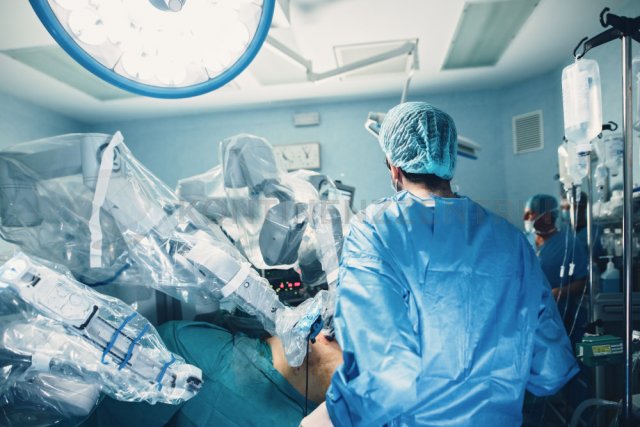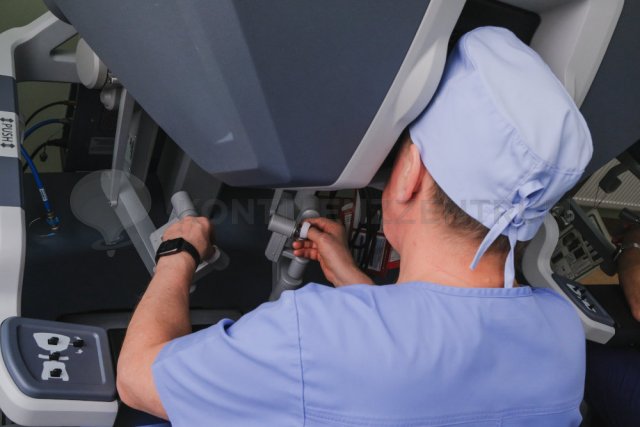DaVinci Operation: Robotic Prolapse Surgery
Pelvic prolapse symptoms cannot always be treated conservatively. In some cases, surgery is required to treat the symptoms of bladder prolapse or uterine prolapse in the best way possible.
The surgical treatment of prolapse of the bladder, uterus, vaginal end or parts of the bowel can be carried out in various ways:
- through the vagina
- via an incision in the lower abdomen
- with small abdominal incisions for laparoscopy
In surgery, laparoscopy is also known as the keyhole method or laparoscopy due to the small access routes.
Compared to open surgical methods, it has many advantages for prolapse of the bladder, pelvic floor, bowel or uterus.

Learn more
Organ prolapse can be treated very effectively. Contact our experienced specialists for a consultation; we will be happy to inform you about your individual treatment options.
DaVinci Robotic Surgery: Advantages for Patients with Organ Prolapse
Laparoscopic procedures are increasingly being performed using robot-assisted surgical systems, e.g. as DaVinci operation with the DaVinci® robot. Compared to surgical methods in which the surgical area is completely opened, this method offers significant advantages for the patient:
- Usually less blood loss
- Usually less pain medication needed after the operation
- Shorter stay in hospital
- Minor scars
DaVinci Surgical System Enables Precise Procedures
The DaVinci operation robot can be used in surgical disciplines (e.g. urology, gynecology, etc.) for various clinical scenarios. In addition to treating pelvic prolapse, the doctor can use a surgical robot to perform a radical prostatectomy, e.g. for prostate cancer, in which the entire prostate is removed. At the Swiss KontinenzZentrum Hirslanden, our surgeons use this method primarily in uro-gynecology for pelvic organ prolapse surgery.
The robot-assisted systems transfer the surgeon's hand movements very precisely from a control console to the surgical instruments. The doctor can use the DaVinci operation robot to make much smaller and more precise incisions. This protects the patient's tissue and nerve tracts as much as possible. A robot-assisted surgical system allows the instruments to be rotated 360 degrees, enabling incision and suturing techniques that cannot be performed using conventional surgical techniques. During the procedure, the surgeon can see the surgical site at ten times magnification with a high-resolution 3D camera, giving them a three-dimensional view. This results in improved depth perception. The surgical robot only performs the movements specified by the surgeon.
How does a Urologist Perform a Prolapse Operation with the DaVinci® Robot?
During Da Vinci surgery for pelvic prolapse, the surgeon first inserts a small guide sleeve through an initial incision in the area of the navel. Carbon dioxide is introduced into the abdominal cavity through the opening. This creates a cavity in the abdomen, which improves the view of the organs.
The doctor inserts additional guide sleeves through further small incisions in the abdominal wall. The arms of the robotic system (with camera and special instruments) are placed on the guide sleeves.
During the DaVinci robotic prolapse surgery, the surgeon opens the tissue gaps between the vagina on the one hand and the bladder and rectum on the other. A synthetic, mesh-like fabric is sutured in there and attached to the front edge of the sacrum.
By supporting the pelvic floor in this way, the lowered organs are moved back to their original position in the pelvis.
Laparoscopic robot-assisted sacrocolpopexy achieves equivalent surgical results compared to the open surgical method. At the same time, thanks to the high-precision instruments, it usually results in less blood loss, less pain, a shorter hospital stay and smaller scars.

Important Information before the Da Vinci Operation
Please inform the surgeon about your medication. The attending physician will then decide whether and when these medications need to be discontinued or replaced by another medication. In particular, this includes anticoagulant medications (e.g. Marcumar®, Aspirin®, Plavix®, Pradaxa®, Xarelto®) and, in the case of diabetics, metformin-containing medications.
What Should you Bear in Mind After a Prolapse Operation?
After a Da Vinci operation in uro-gynecology, patients should follow a few rules of conduct to support complication-free wound healing.
- Take it easy for about 2-3 months after the operation!
- Avoid any strain during this time:
- Do not lift anything heavy
- Exercise regularly
- Reduce your weight if necessary
- Drink plenty of fluids to flush the bladder well
- Ensure normal bowel movements by eating a diet rich in fiber.
- If you experience any symptoms, such as fever, persistent nausea, vomiting, abdominal pain or heavy bleeding, please contact your doctor immediately, even if these symptoms only occur a few days after the procedure!
- Please refrain from sexual intercourse until the follow-up examination!
- Please go for a check-up and carry out any prescribed pelvic floor exercises very regularly.
Pelvic prolapse can be precisely reconstructed using Da Vinci robotic prolapse surgery. Compared to open surgical methods, surgery with a Da Vinci robot offers many advantages - for both the surgeon and the patient.
Get in touch with us
During a consultation with our experienced specialists, we will be happy to advise you on your individual treatment options, such as robot-assisted reconstruction with the DaVinci® robot.
You can reach our KontinenzZentrum Hirslanden in Zurich from Monday to Friday, 8 am to 5 pm. You are welcome to contact us by phone or e-mail or make an online appointment.
